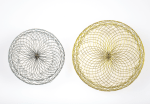Coronary calcifications pose a complex challenge with a high incidence (25% of all angioplasties), thus implying difficult management and adverse long-term outcomes, such as an increased risk of events, especially the need for repeat revascularization. The main mechanisms of long-term failure include stent underexpansion and, in particular, minimal post-deployment stent area. Intravascular lithotripsy (IVL) has<a href="https://solaci.org/en/2024/05/28/is-intravascular-lithotripsy-equally-effective-in-all-coronary-calcification-patterns/" title="Read more" >...</a>
TAVR vs SAVR in Los Risk Patients: 10-Year Outcomes of the NOTION Trial
Transcatheter aortic valve replacement (TAVR) has revolutionized the treatment of patients with severe aortic stenosis (AS). Randomized studies have shown the benefits of TAVR in patients at prohibitive surgical risk, as well as high and intermediate risk. The NOTION trial (Nordic Aortic Valve Intervention Trial) randomized patients with low risk severe AS to TAVR and<a href="https://solaci.org/en/2024/05/28/tavr-vs-savr-in-los-risk-patients-10-year-outcomes-of-the-notion-trial/" title="Read more" >...</a>
Functional Assessment Using QFR for the Revascularization of Non-Culprit Lesions in AMI Patients
Nowadays, evidence from studies and meta-analyses has demonstrated the benefits of complete revascularization compared to culprit-vessel-only revascularization in patients with acute myocardial infarction (AMI). The identification and treatment of non-culprit lesions can be guided by conventional angiography, intracoronary imaging, or coronary physiology; the optimal modality, however, is still unclear. Quantitative flow ratio (QFR) is a<a href="https://solaci.org/en/2024/05/22/functional-assessment-using-qfr-for-the-revascularization-of-non-culprit-lesions-in-ami-patients/" title="Read more" >...</a>
EuroPCR 2024 | NOTION-2: TAVI vs SAVR, Randomized Study on Low-Risk Young Patients with Severe Tricuspid Disease or Bicuspid Stenosis
Many of the studies comparing TAVR against SAVR in low risk patients included patients between 70-75 years, excluding those with tricuspid valves. This study included low surgical risk patients with severe aortic stenosis and symptoms, 75 years or younger. Participants were randomized 1:1 to receiving TAVR or SAVR, stratified according to sex, need for new<a href="https://solaci.org/en/2024/05/17/europcr-2024-notion-2-tavi-vs-savr-randomized-study-on-low-risk-young-patients-with-severe-tricuspid-disease-or-bicuspid-stenosis/" title="Read more" >...</a>
EuroPCR 2024 | OBSERVANT II: TAVR in the “Real World”
This study analyzed 2,493 “real world” patients, 1,352 receiving the Evolut R/Pro, 675 the SAPIEN, 3,270 the Acurate Neo and 192 the Portico. Primary end point was all cause mortality and major adverse cardiovascular events (MACE) at 5 years. Populations were similar, with EuroSCORE 4.9%, and there were no significant differences in comorbidities or echocardiographic<a href="https://solaci.org/en/2024/05/15/europcr-2024-observant-ii-tavr-in-the-real-world/" title="Read more" >...</a>
Aortic Stenosis Progression Evolution
Aortic stenosis is an increasingly common valvulopathy because people are living longer now. A present, the main treatment consists of surgical (SAVR) or transcatheter aortic valve replacement. (TAVR). One of the main challenges of this disease is its progression. The European guidelines recommend Doppler echocardiograms every 2 to 3 years for mild cases, mildly calcified,<a href="https://solaci.org/en/2024/05/15/aortic-stenosis-progression-evolution/" title="Read more" >...</a>
Quality of Life in Medium-Risk Patients Treated with TAVR vs SAVR
Transcatheter aortic valve replacement (TAVR) and surgical aortic valve replacement (SAVR) have demonstrated similar outcomes in symptomatic aortic stenosis patients (at high or intermediate risk) in terms of 5-year survival. When evaluating the quality of life (QoL) of these two treatment strategies in patients with high surgical risk, there were no significant differences at 5<a href="https://solaci.org/en/2024/05/10/quality-of-life-in-medium-risk-patients-treated-with-tavr-vs-savr/" title="Read more" >...</a>
Evolution of Leak in Left Atrial Appendage Closure
Atrial fibrillation is common in elderly people and is associated with a higher risk of ischemic stroke. Left atrial appendage occlusion (LAAO) is a valid strategy, especially in patients at high risk of bleeding. The presence of peridevice leak (PDL) has been linked to stroke, although some analyses, such as the PROTEC-AF Study, suggest that<a href="https://solaci.org/en/2024/05/08/evolution-of-leak-in-left-atrial-appendage-closure/" title="Read more" >...</a>
Acute Myocardial Infarction After TAVI: Retrospective Analysis of >200,000 Implants
Coronary artery disease is common among patients considered for transcatheter aortic valve implantation (TAVI). With the expansion of the indication for TAVI to a population with lower surgical risk, and therefore younger, there has been a gradual increase in the incidence of coronary events. However, there is limited data on treatment strategy and outcomes in<a href="https://solaci.org/en/2024/05/04/acute-myocardial-infarction-after-tavi-retrospective-analysis-of-200000-implants/" title="Read more" >...</a>
12-Month Evolution of Edge-to-Edge Repair with PASCAL
Mitral regurgitation (MR) is the most frequent valve disease. Mitral transcatheter edge-to-edge repair (M-TEER) has been shown beneficial in high or prohibitive risk patients in cases of degenerative and functional MR. The PASCAL device has been shown safe and effective by the CLASP II, but we still need further research in clinical “real world” environments. <a href="https://solaci.org/en/2024/05/02/12-month-evolution-of-edge-to-edge-repair-with-pascal/" title="Read more" >...</a>








